Inkyu Lee
Large-Scale AI in Telecom: Charting the Roadmap for Innovation, Scalability, and Enhanced Digital Experiences
Mar 06, 2025Abstract:This white paper discusses the role of large-scale AI in the telecommunications industry, with a specific focus on the potential of generative AI to revolutionize network functions and user experiences, especially in the context of 6G systems. It highlights the development and deployment of Large Telecom Models (LTMs), which are tailored AI models designed to address the complex challenges faced by modern telecom networks. The paper covers a wide range of topics, from the architecture and deployment strategies of LTMs to their applications in network management, resource allocation, and optimization. It also explores the regulatory, ethical, and standardization considerations for LTMs, offering insights into their future integration into telecom infrastructure. The goal is to provide a comprehensive roadmap for the adoption of LTMs to enhance scalability, performance, and user-centric innovation in telecom networks.
Sum Secrecy Rate Maximization for IRS-aided Multi-Cluster MIMO-NOMA Terahertz Systems
May 15, 2023Abstract:Intelligent reflecting surface (IRS) is a promising and disruptive technique to extend the network coverage and improve spectral efficiency. This paper investigates an IRS-assisted Terahertz (THz) multiple-input multiple-output (MIMO)-nonorthogonal multiple access (NOMA) system based on hybrid precoding in the presence of eavesdropper. Two types of sparse RF chain antenna structures are adopted, i.e., sub-connected structure and fully connected structure. Cluster heads are firstly selected for transmissions, and discrete phase-based analog precoding is designed for the transmit beamforming. Subsequently, based on the channel conditions, the users are grouped into multiple clusters, and each cluster is transmitted by using the NOMA technique. In addition, a low complexity zero-forcing method is employed to design digital precoding so as to eliminate interference between clusters. On this basis, we propose a secure transmission scheme to maximize the sum secrecy rate by jointly optimizing the power allocation and phase shifts of IRS under the constraints of system transmission power, achievable rate requirement of each user, and IRS phase shifts. Due to multiple coupled variables, the formulated problem leads to a non-convex issue. We apply the Taylor series expansion and semidefinite programming to convert the original non-convex problem into a convex one. Then, an alternating optimization algorithm is developed to obtain a feasible solution of the original problem. Simulation results are demonstrated to validate the convergence of the proposed algorithm, and confirm that the deployment of IRS can significantly improve the secrecy performance.
Deep Learning for Multi-User MIMO Systems: Joint Design of Pilot, Limited Feedback, and Precoding
Sep 21, 2022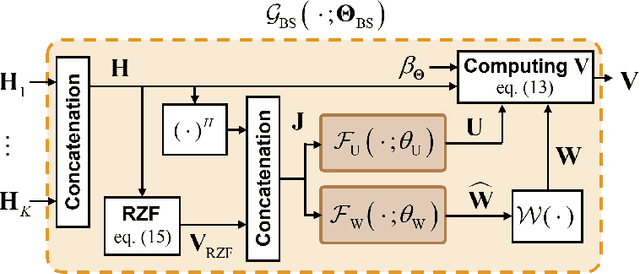
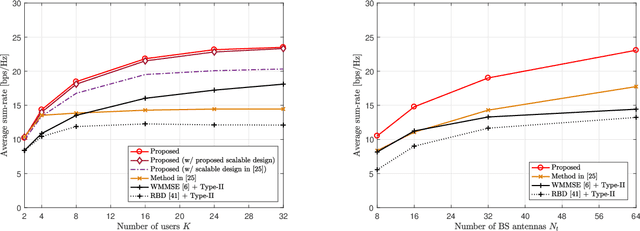
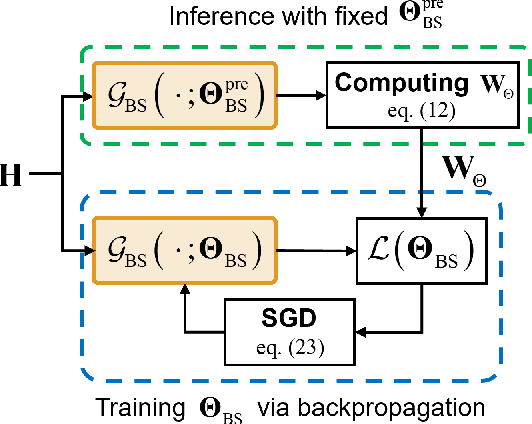
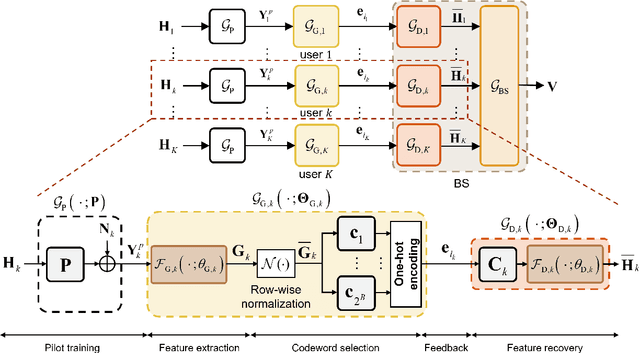
Abstract:In conventional multi-user multiple-input multiple-output (MU-MIMO) systems with frequency division duplexing (FDD), channel acquisition and precoder optimization processes have been designed separately although they are highly coupled. This paper studies an end-to-end design of downlink MU-MIMO systems which include pilot sequences, limited feedback, and precoding. To address this problem, we propose a novel deep learning (DL) framework which jointly optimizes the feedback information generation at users and the precoder design at a base station (BS). Each procedure in the MU-MIMO systems is replaced by intelligently designed multiple deep neural networks (DNN) units. At the BS, a neural network generates pilot sequences and helps the users obtain accurate channel state information. At each user, the channel feedback operation is carried out in a distributed manner by an individual user DNN. Then, another BS DNN collects feedback information from the users and determines the MIMO precoding matrices. A joint training algorithm is proposed to optimize all DNN units in an end-to-end manner. In addition, a training strategy which can avoid retraining for different network sizes for a scalable design is proposed. Numerical results demonstrate the effectiveness of the proposed DL framework compared to classical optimization techniques and other conventional DNN schemes.
A Codebook Design for FD-MIMO Systems with Multi-Panel Array
Aug 09, 2022



Abstract:In this work, we study codebook designs for full-dimension multiple-input multiple-output (FD-MIMO) systems with a multi-panel array (MPA). We propose novel codebooks which allow precise beam structures for MPA FD-MIMO systems by investigating the physical properties and alignments of the panels. We specifically exploit the characteristic that a group of antennas in a vertical direction exhibit more correlation than those in a horizontal direction. This enables an economical use of feedback bits while constructing finer beams compared to conventional codebooks. The codebook is further improved by dynamically allocating the feedback bits on multiple parts such as beam amplitude and co-phasing coefficients using reinforcement learning. The numerical results confirm the effectiveness of the proposed approach in terms of both performance and computational complexity.
Deep Learning Based Resource Assignment for Wireless Networks
Sep 27, 2021



Abstract:This paper studies a deep learning approach for binary assignment problems in wireless networks, which identifies binary variables for permutation matrices. This poses challenges in designing a structure of a neural network and its training strategies for generating feasible assignment solutions. To this end, this paper develop a new Sinkhorn neural network which learns a non-convex projection task onto a set of permutation matrices. An unsupervised training algorithm is proposed where the Sinkhorn neural network can be applied to network assignment problems. Numerical results demonstrate the effectiveness of the proposed method in various network scenarios.
Deep Learning-based Limited Feedback Designs for MIMO Systems
Dec 19, 2019



Abstract:We study a deep learning (DL) based limited feedback methods for multi-antenna systems. Deep neural networks (DNNs) are introduced to replace an end-to-end limited feedback procedure including pilot-aided channel training process, channel codebook design, and beamforming vector selection. The DNNs are trained to yield binary feedback information as well as an efficient beamforming vector which maximizes the effective channel gain. Compared to conventional limited feedback schemes, the proposed DL method shows an 1 dB symbol error rate (SER) gain with reduced computational complexity.
Deep Learning Framework for Wireless Systems: Applications to Optical Wireless Communications
Dec 13, 2018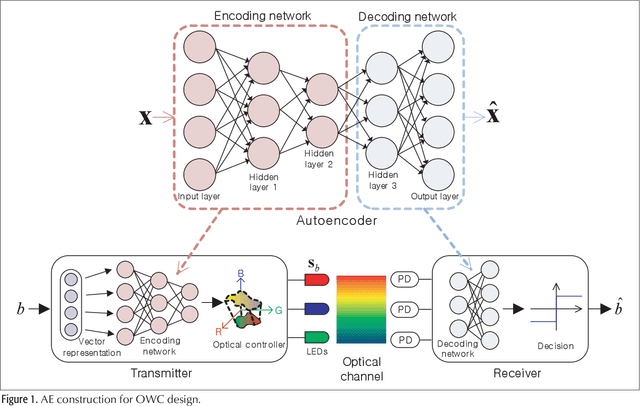
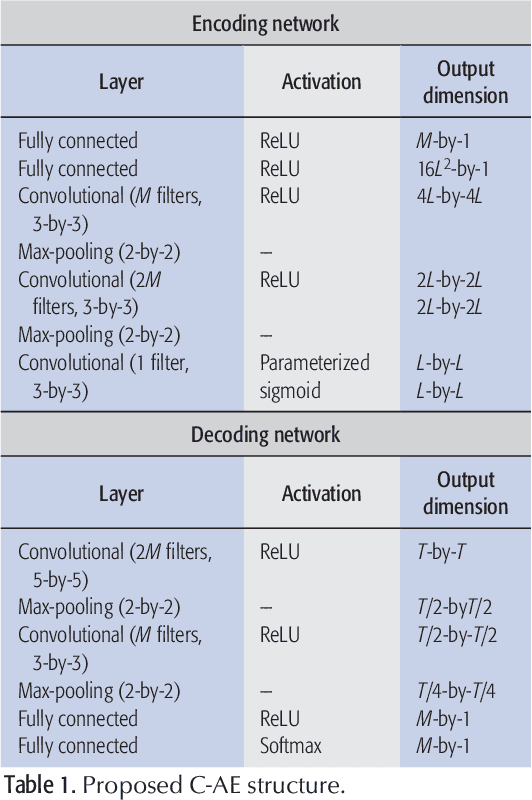
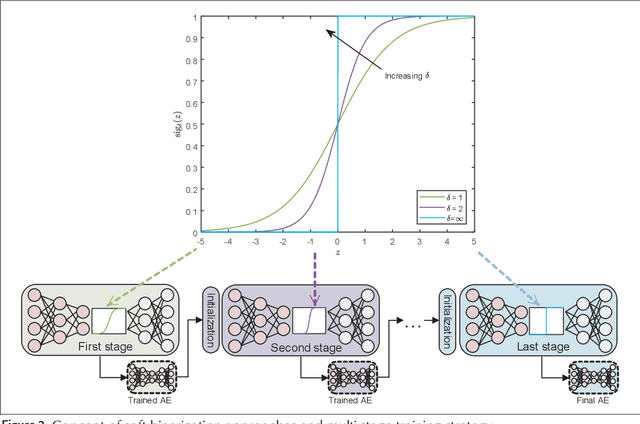
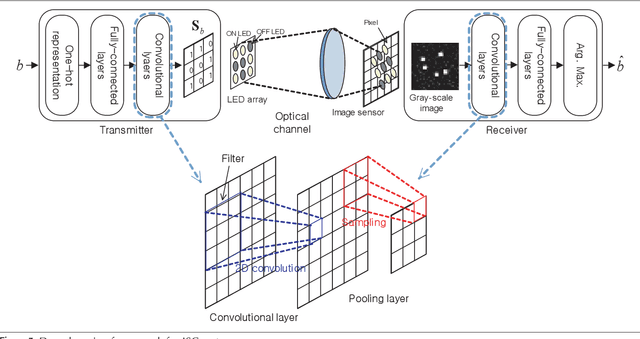
Abstract:Optical wireless communication (OWC) is a promising technology for future wireless communications owing to its potentials for cost-effective network deployment and high data rate. There are several implementation issues in the OWC which have not been encountered in radio frequency wireless communications. First, practical OWC transmitters need an illumination control on color, intensity, and luminance, etc., which poses complicated modulation design challenges. Furthermore, signal-dependent properties of optical channels raise non-trivial challenges both in modulation and demodulation of the optical signals. To tackle such difficulties, deep learning (DL) technologies can be applied for optical wireless transceiver design. This article addresses recent efforts on DL-based OWC system designs. A DL framework for emerging image sensor communication is proposed and its feasibility is verified by simulation. Finally, technical challenges and implementation issues for the DL-based optical wireless technology are discussed.
 Add to Chrome
Add to Chrome Add to Firefox
Add to Firefox Add to Edge
Add to Edge